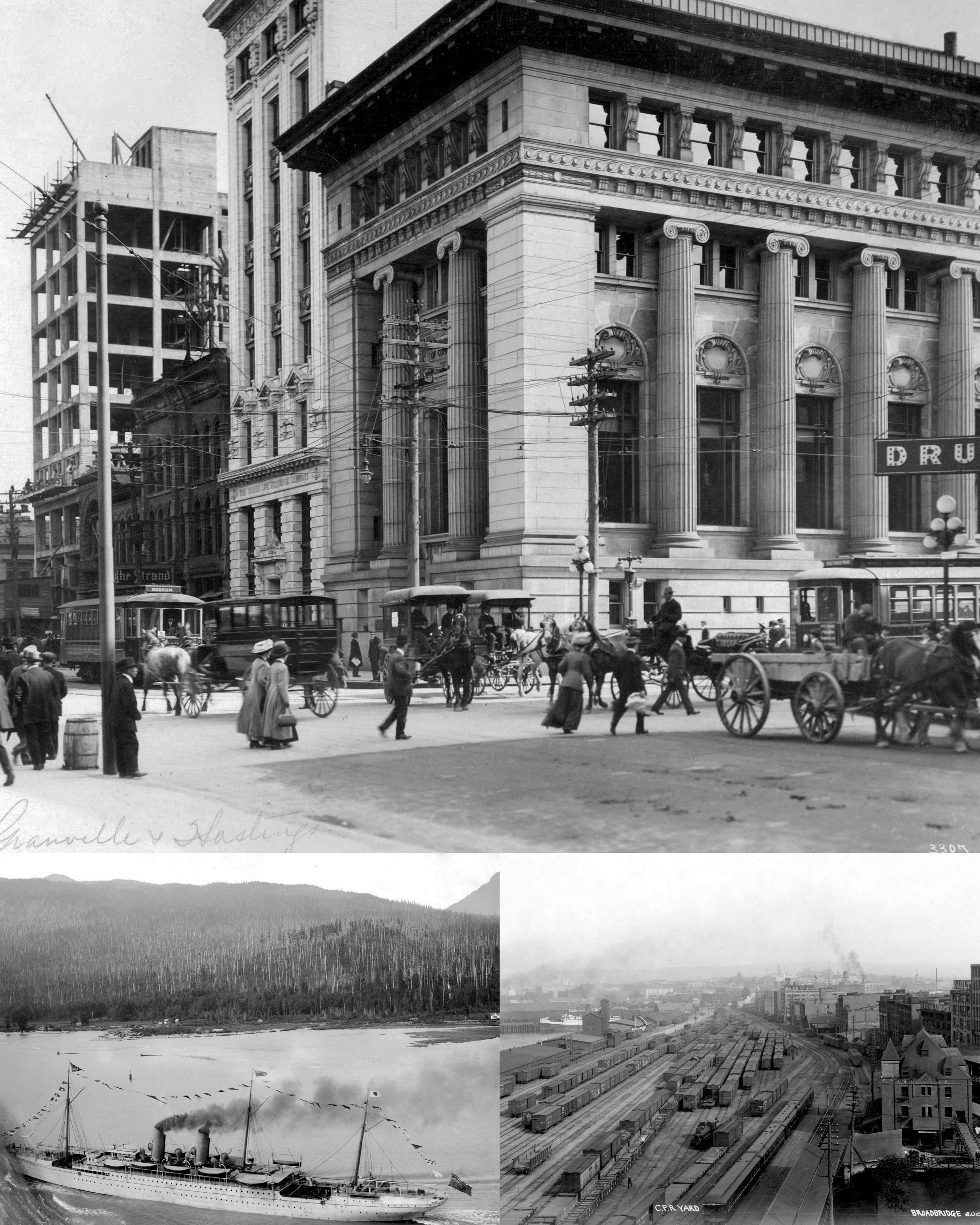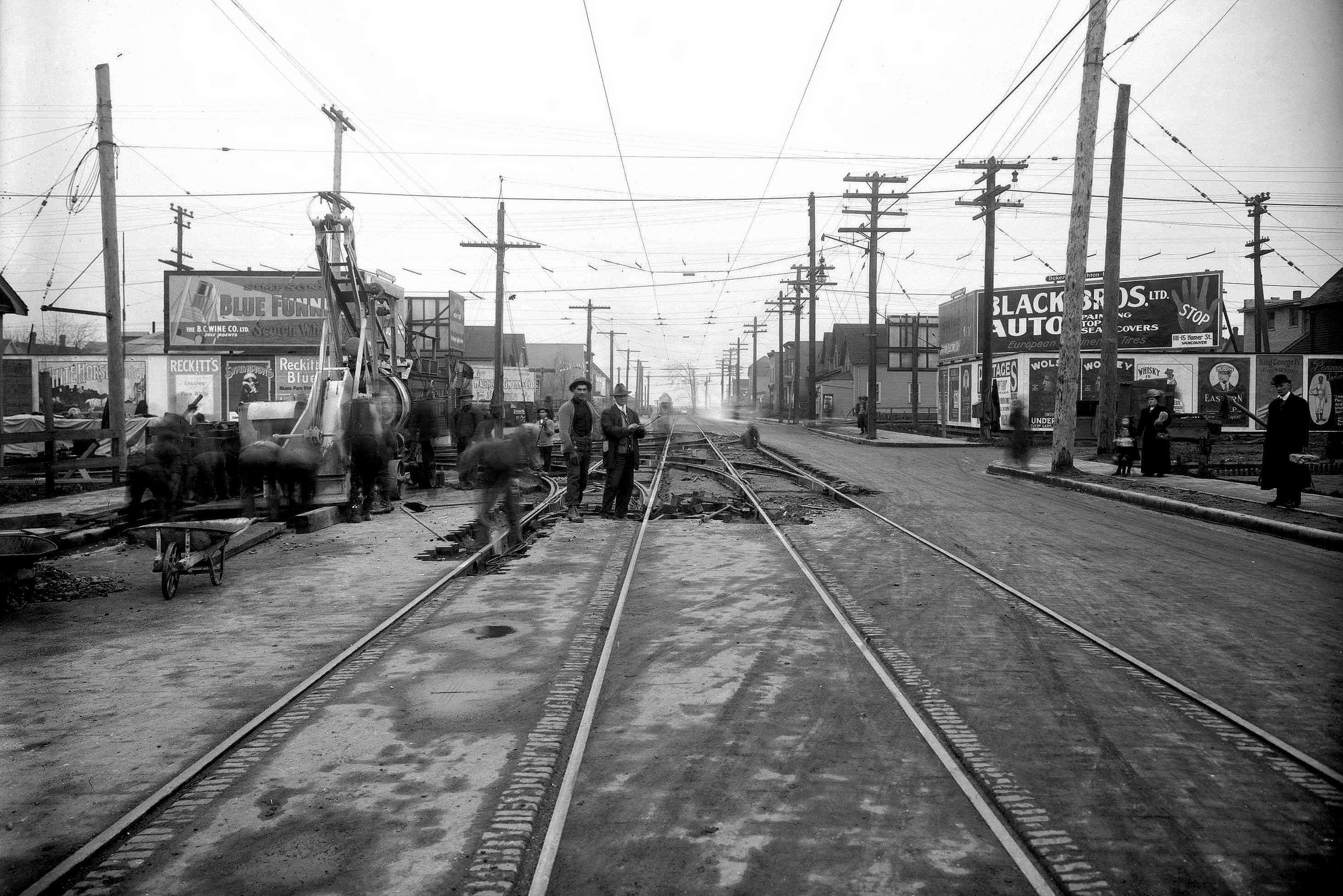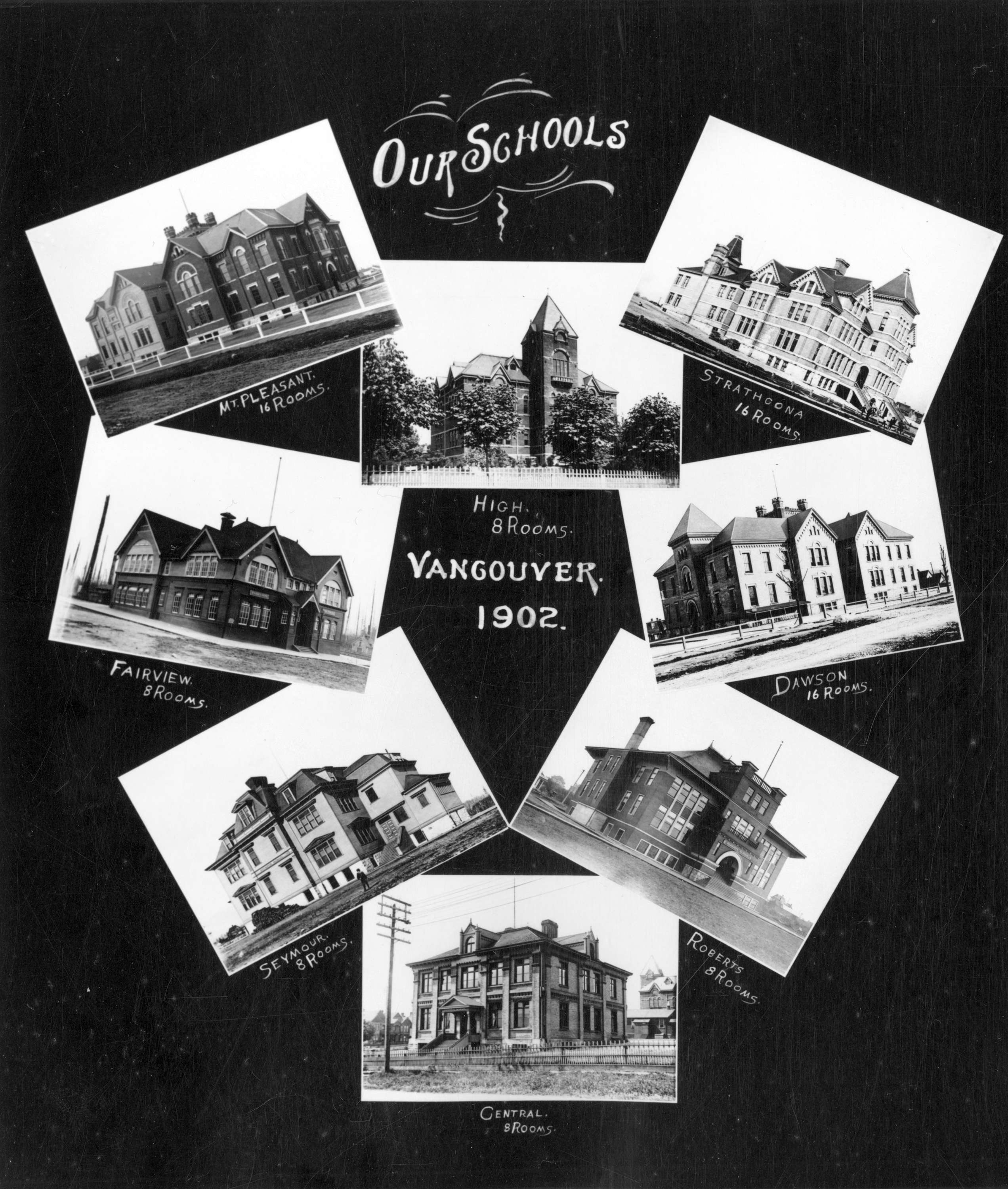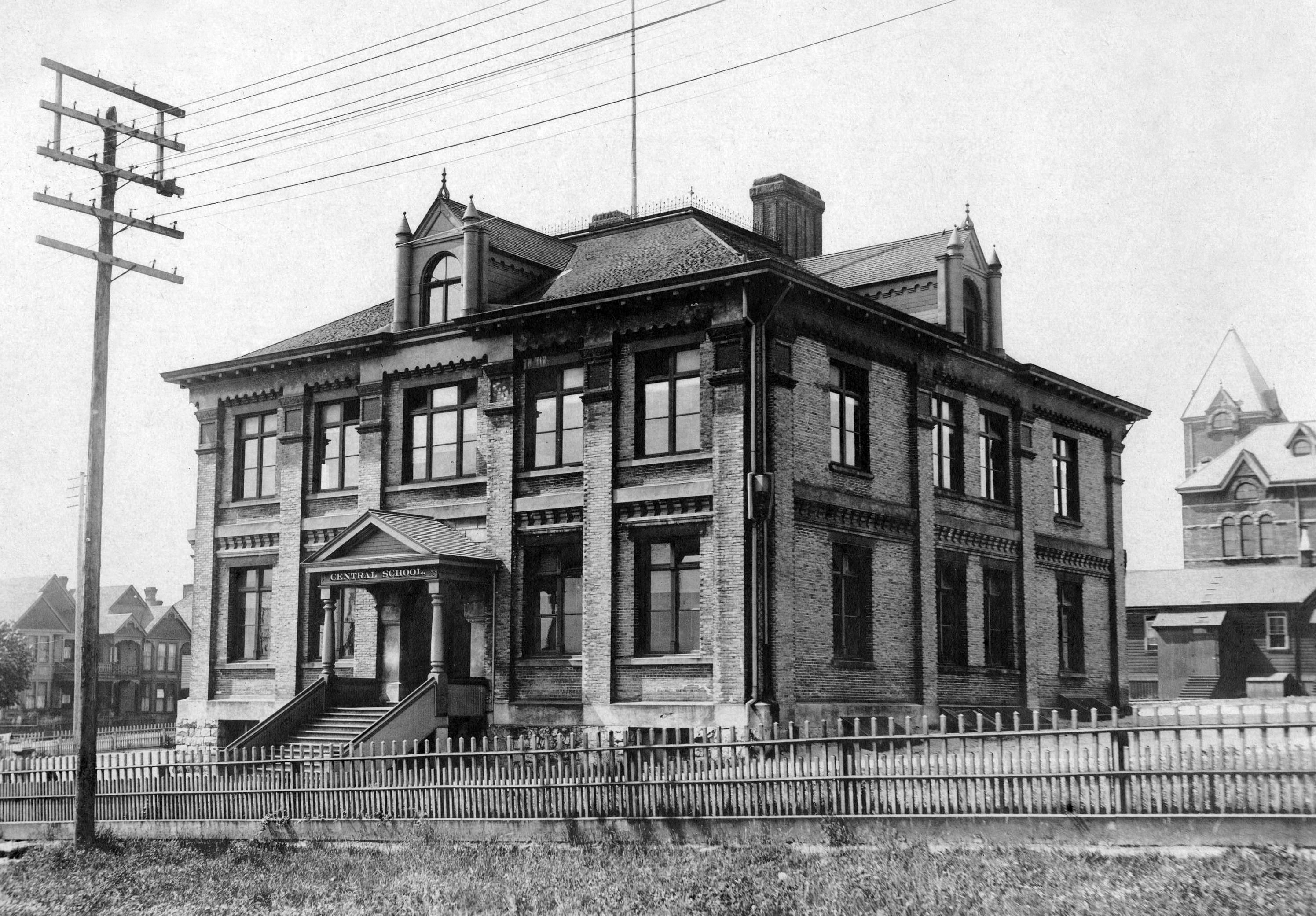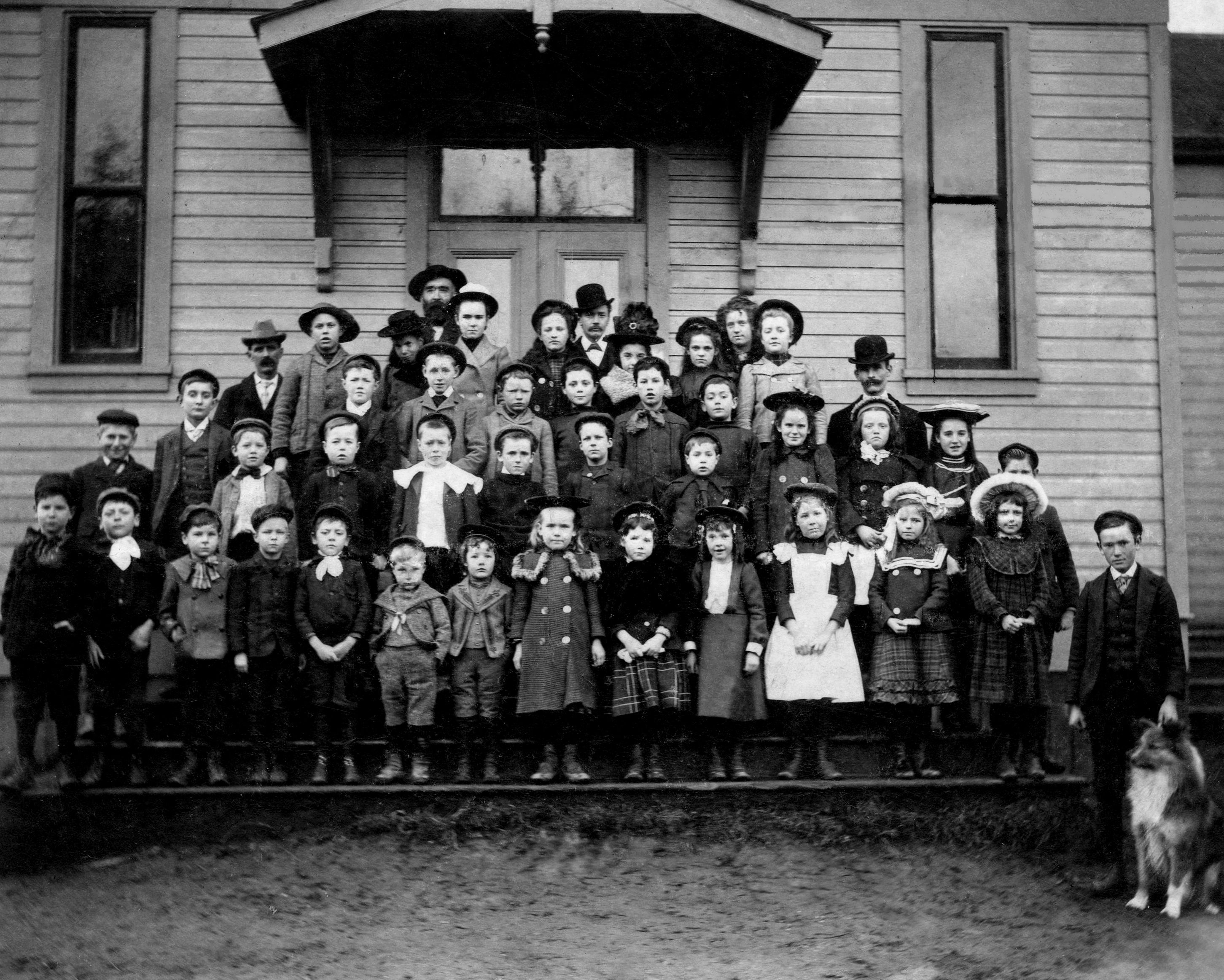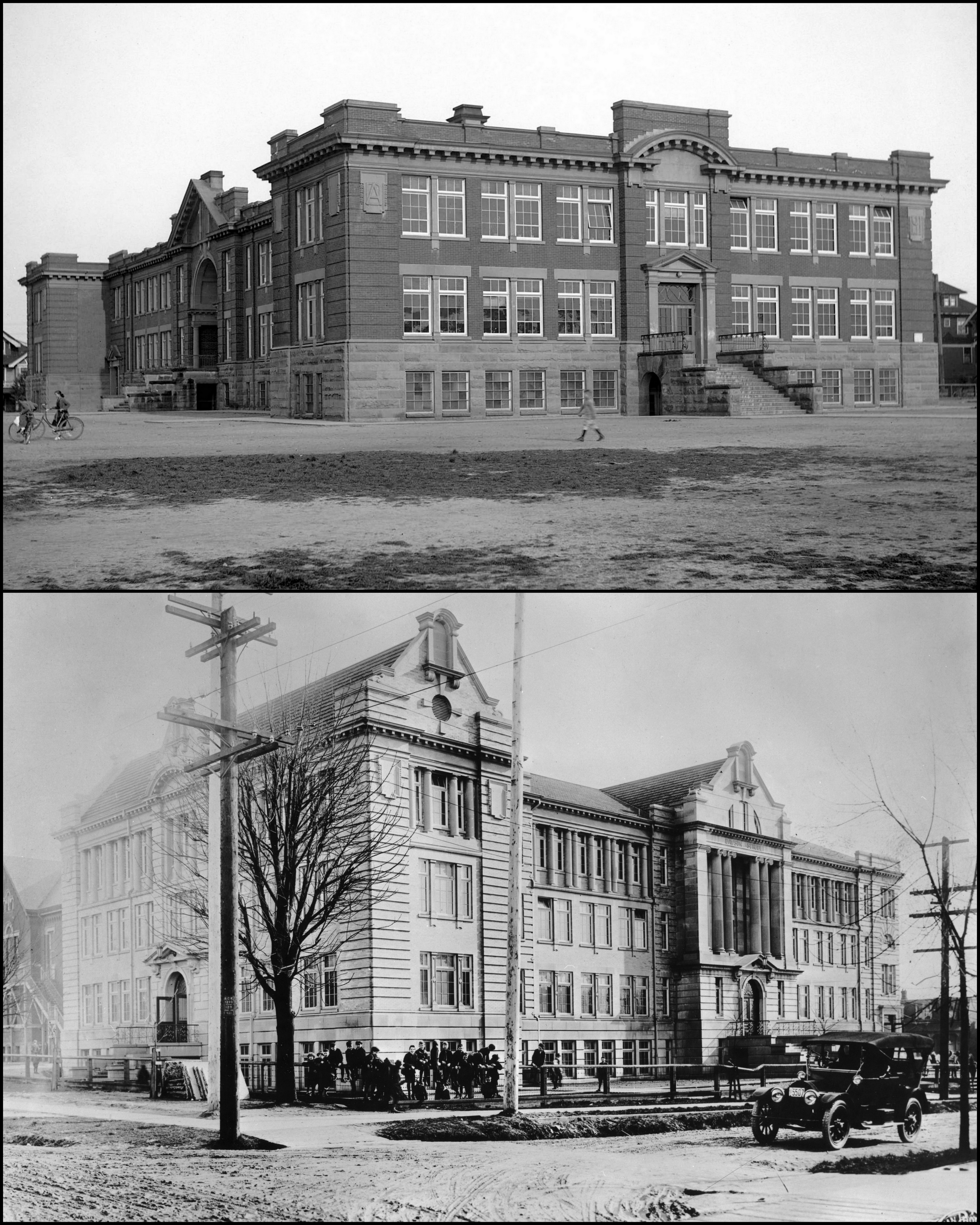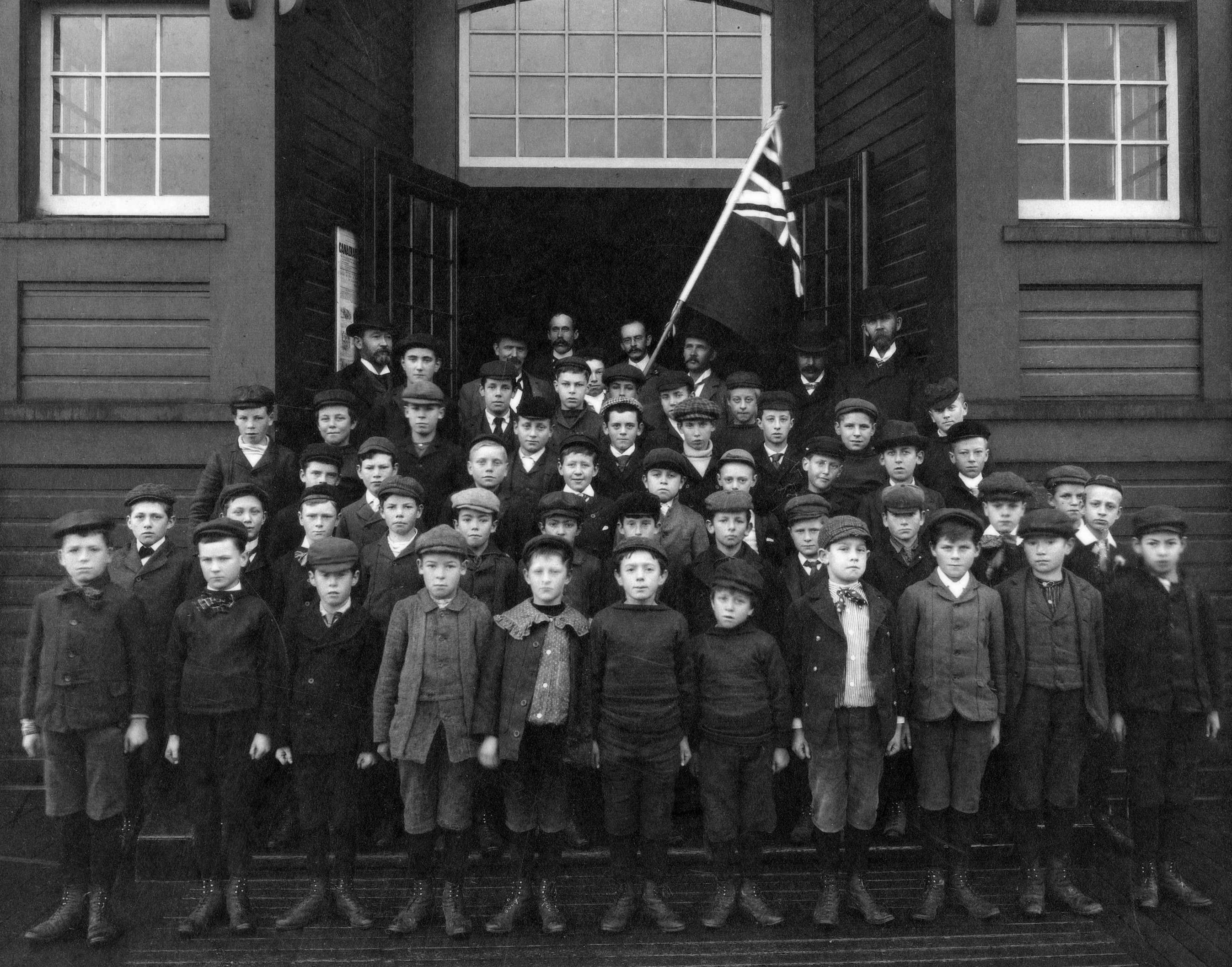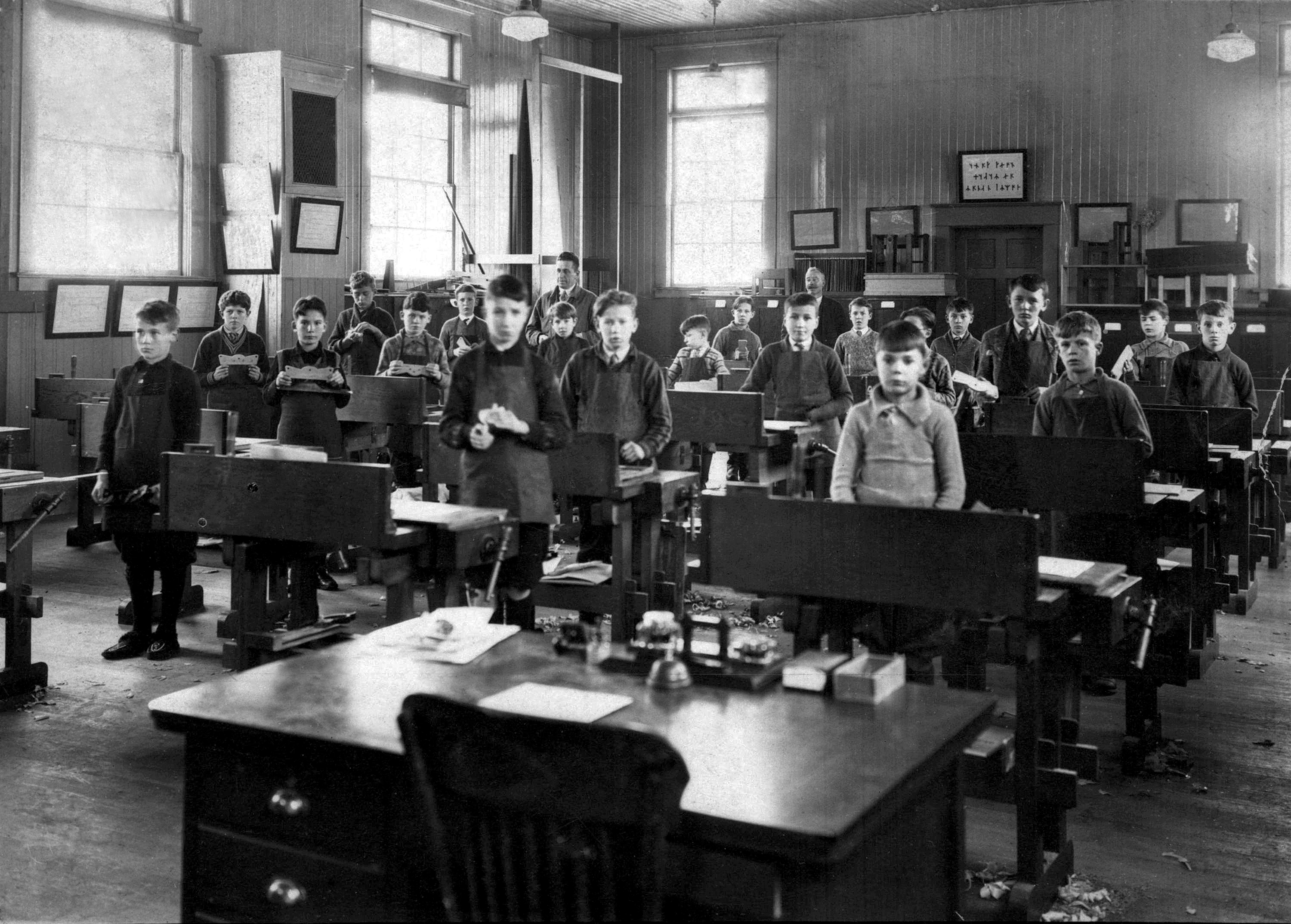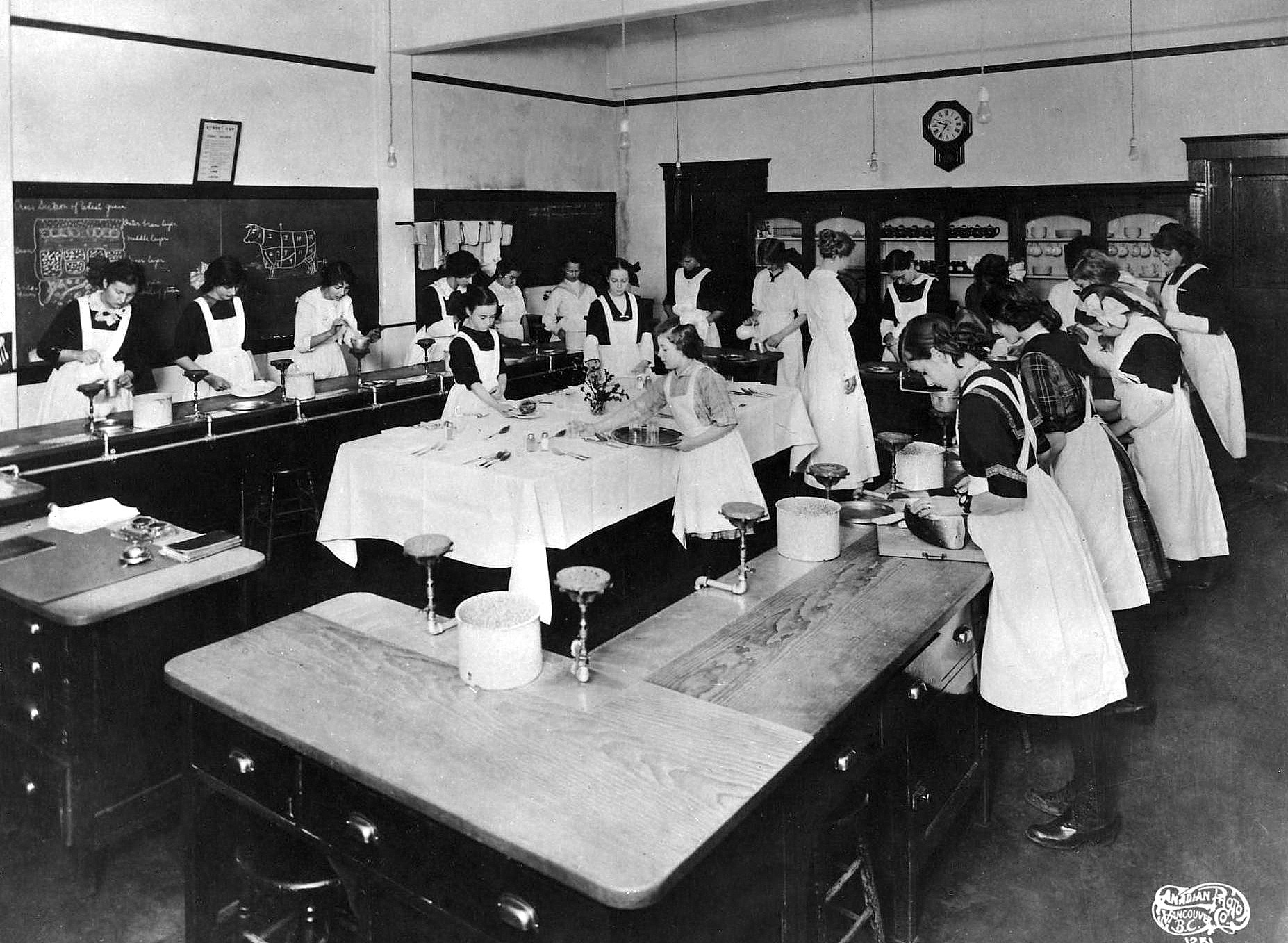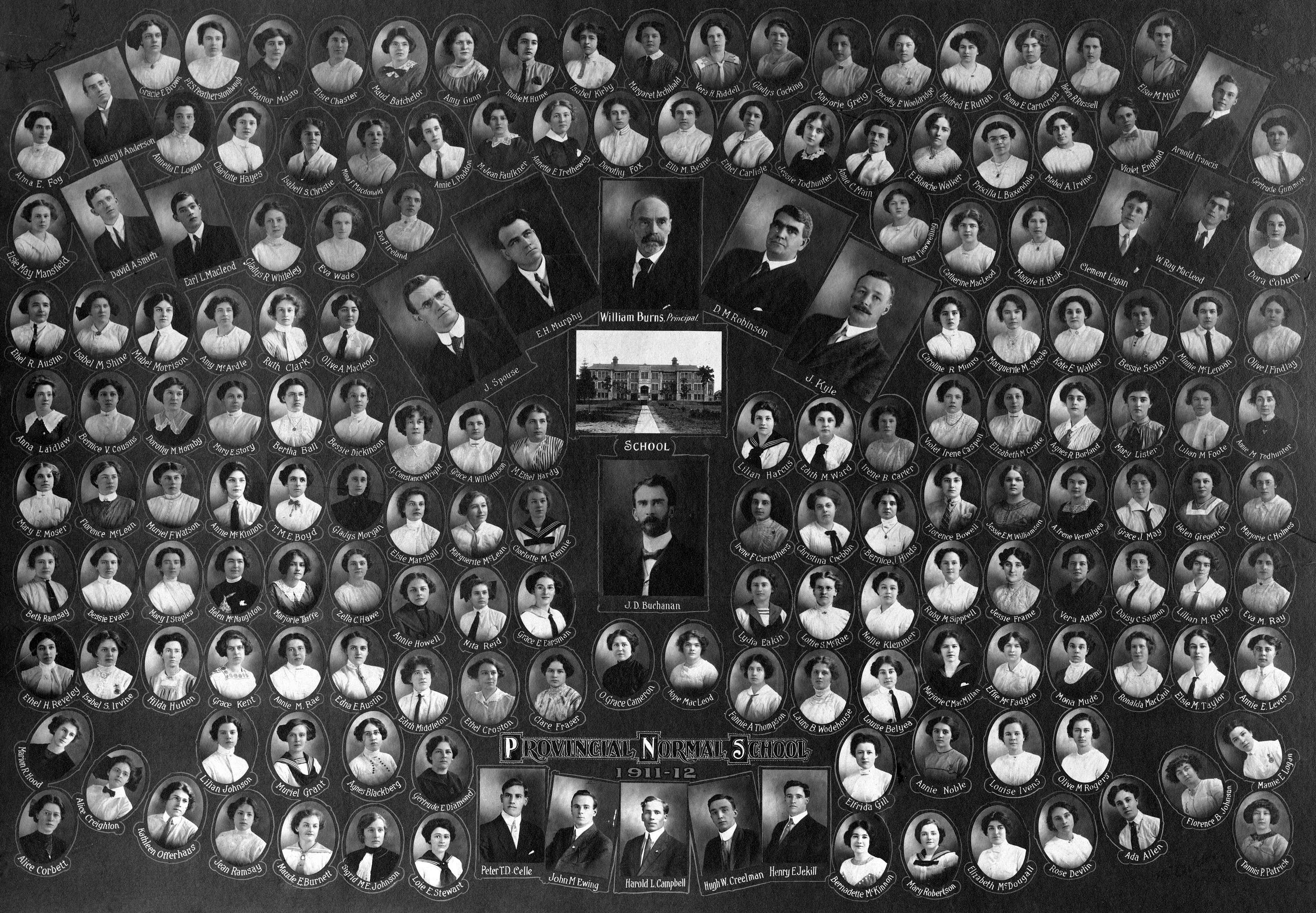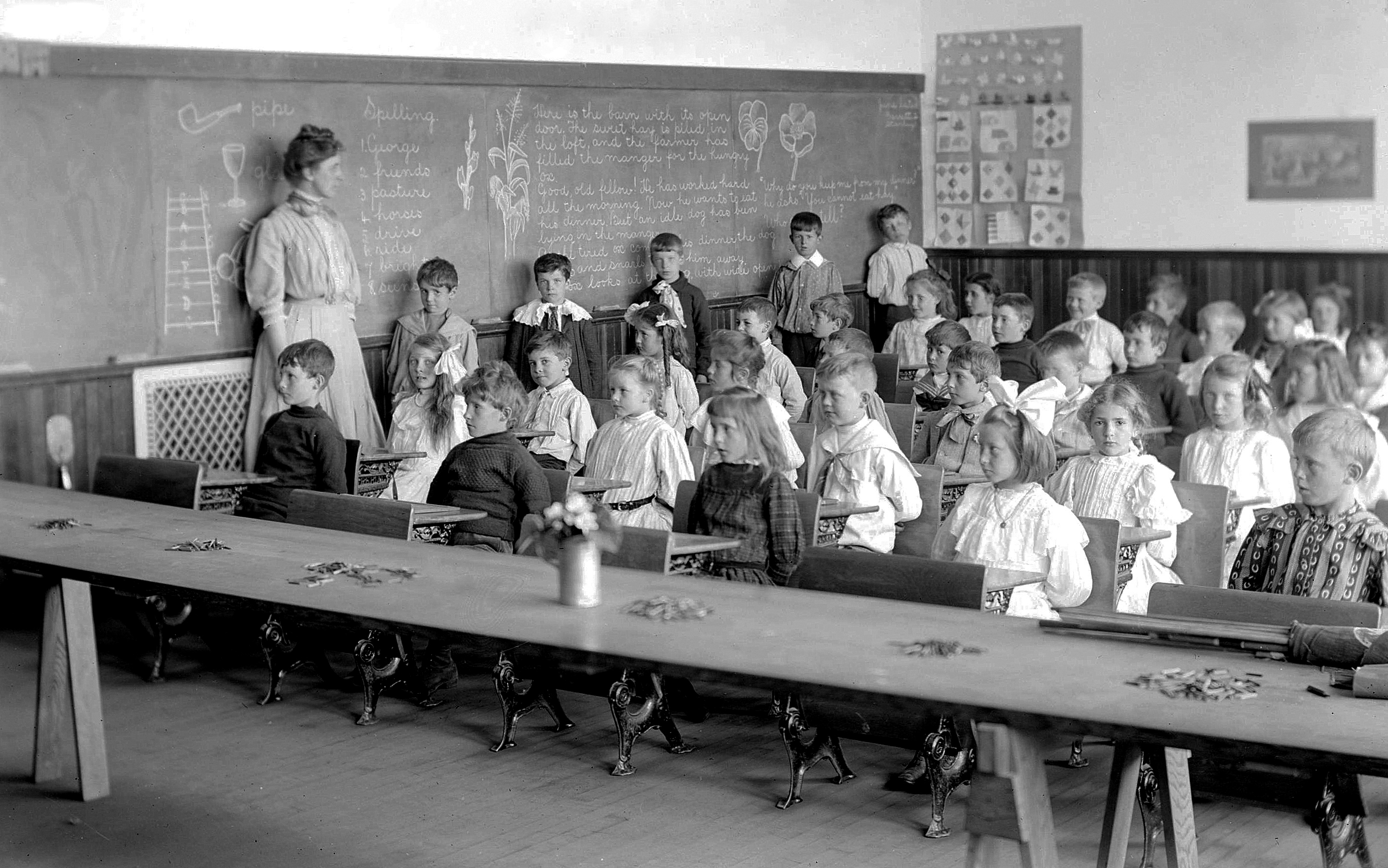Chapter Two: 1891 – 1910
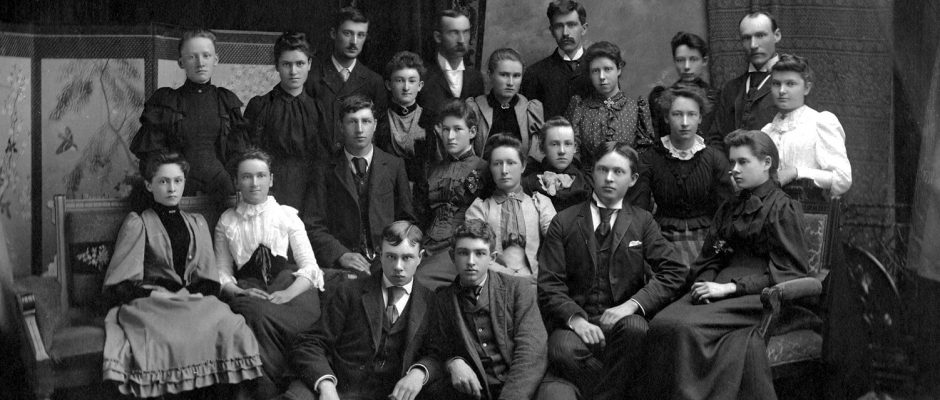
Vancouver High School: Senior Class (1892)
1. Introduction
During these two decades, Vancouver experienced a population explosion and rapid economic growth. Government restrictions on immigration dictated that the ethnic character of the population remain white and English speaking. Many new elementary schools were built, as well as Vancouver’s first high school. The instructional program was expanded to include physical and vocational training, domestic science, and the visual and performing arts. Teacher training underwent a major reform.
2. Population Growth
By 1891, Vancouver’s population had reached 13,000. Ten years later the population of the area between Burrard Inlet and the Fraser River had doubled in size to about 27,000. By 1911, the population had mushroomed to 115,000.
One reason for this rapid growth was that Vancouver was situated on the best natural harbour on the northern Pacific Coast. It was also the Pacific terminus of the Canadian Pacific Railway. This made it a key link in the most direct trade route linking Great Britain and the Far East. Another factor was that Vancouver was home to a growing number of sawmills and related industries processing timber from the vast forests that surrounded the city and covered the nearby mountains and coastal areas.
Top: Downtown Vancouver in 1910. Bottom (L): The Empress of India sails through the First Narrows (1890). Bottom (R): The CPR station at the foot of Granville Street.
School enrollment also grew dramatically during this period. This was due to several factors:
- The rapid growth of the general population.
- A high birthrate and large average family size.
- Compulsory school attendance for children aged 7 – 14.
- A small but growing number of students going on to high school.
The result was a rapid expansion in the number of schools. Despite this, the demand for classroom space and teachers often exceeded supply and overcrowded classrooms taught by teachers – mainly young women with little formal training – were commonplace.
At the close of the midsummer term of 1890 the schools had once more outgrown their accommodation, and it was decided to build another new eight-room school in the east end of the town, where the bulk of the population still lived.
The following year – (1894) – these three new buildings were ready for occupation and another four-roomed building was also added: and by the year 1895 it was found necessary to add four more rooms to each of the three new schools in the east, west and southern parts of the city.
In 1896, and appropriation of $70,000 was made for the purpose of doubling the capacity of the schools in the east, west and southern portions of the city, which had already been enlarged once.
By the year 1900-01 the school population had increased (to) 3,907… In the ten years following, the increase has been more wonderful still, the school enrollment having increased from 4669 in 1901 to 10,240 in 1911, the High School attendance from 219 to 709, the teaching staff from 84 to 250…
Excerpts from The Romance of Vancouver’s Schools
3. Three School Districts
Present-day Vancouver is much larger than the city of 1886. Areas that were subsequently annexed include the large District of South Vancouver (incorporated in 1892 and divided in 1908 into Point Grey and South Vancouver, both of which joined Vancouver in 1929; and Hastings Townsite and District Lot 301, which joined the City in 1911. Early settlement of these areas occurred where streams intersected the trails, roads and electric street railways that connected Vancouver to the Fraser River and New Westminster. Encouraged by the urban markets of Vancouver and New Westminster, settlers established dairy farms, breweries, nurseries, market gardens and slaughter houses. Large areas remained unsettled. Significant barriers, such as the ‘Great Fraser Beaver Swamp,’ separated the individual settlements.
Numerous schools, both in Vancouver and suburban South Vancouver and Point Grey, owe their genesis to the extension of streetcar service to newly subdivided areas during the states of development in their particular neighborhood.
Excerpts from Vancouver Schools: Establishing Their Heritage Value
West Fourth Avenue streetcar line under construction, looking east from Fir Street.
Construction of the street railway system had begun in 1889. By 1891, 21 kilometres of track had been laid. By 1914, 165 kilometres of track were in use. The main railway lines included:
- Fourth Avenue and Broadway
- Fairview and Mount Pleasant
- Interurban line along Kingsway
- Fraser and Main Street
- Hastings and Powell Streets
- Interurban lines: along Kingsway to New Westminster, and Arbutus to Marpole.
Construction of the railway lines often preceded settlement of the areas they serviced, which increased the financial risk to investors in street railway companies. But for the period 1901 to 1911, their gamble paid off. Vancouver experienced a huge construction boom in residential housing. The value of building permits rose from $1 million in 1901 to $20 million in 1911, a figure that wasn’t surpassed until 1929.
4. Ethnic Character of Vancouver’s Population
The largest group of newcomers to Vancouver were Canadian born, while most of the others were from the United States, Great Britain, or the more anglicized parts of the British Empire.
One reason that Vancouver’s population was so homogeneous was that certain groups were openly discriminated against. Beginning in 1880, thousands of Chinese labourers had been brought into British Columbia to work on the Canadian Pacific Railway. In 1885, the Canadian Government, responding to growing anti-Chinese feeling, passed the Chinese Immigration Act. This law required Chinese people arriving in Canada to pay a ‘head tax’ of $50. This tax was raised several times until it reached $500 in 1904. It remained in effect until 1924.
Special rules called covenants barred Chinese people from owning land in Point Grey and Shaughnessy and other neighbourhoods. On occasion, anti-Chinese sentiment led to acts of violence. In 1907, anti-Asian rioters, led by members of the Asiatic Exclusion League tore through the Chinatown neighbourhood in Vancouver in 1907.
Japanese people, who had begun arriving in British Columbia in 1887, also experienced discrimination. During the anti-Asian riots of 1907, Vancouver’s Japantown suffered considerable damage despite the efforts of its residents to protect their property. In 1908, Japan agreed to restrict the number of passports it issued to Japanese persons seeking to immigrate to Canada to a maximum of 400 per year.
People from India were essentially barred from immigrating to Canada. In 1908, the Canadian Government issued a regulation known as the ‘continuous journey’ rule. This rule prohibited the “landing of any specified class of immigrants or any immigrants who have come to Canada otherwise than by continuous journey from the country of which they are natives or citizens and upon through tickets purchased in that country.” The effect of this was to prevent people from India from immigrating to Canada because the great distance between the two countries made ‘continuous voyages’ virtually impossible.
5. Neighbourhoods
The ethnic and cultural homogeneity of Vancouver’s growing population did not extend to its emerging neighbourhoods, which were differentiated to some extent by social class.
- Lower Middle Class: Fairview Heights, Grandview, and Mount Pleasant
- White Collar: Kitsilano
- Upper Class: West End, Shaughnessy
The most socially diverse neighbourhoods were Strathcona, Chinatown and Japantown, which were populated by working class families, and ethnic minorities barred from settling in other neighbourhoods by race-based restrictive covenants.
Example of a restrictive covenant dated October 14th, 1928:
The Grantee or his heirs, administrators, executor, successors or assigns will not sell to, agree to sell to, rent to, lease to, or permit or allow to occupy, the said lands and premises, or any part thereof, any person of the Chinese, Japanese or other Asiatic race or to any Indian or Negro.”
6. New Schools
a) CITY OF VANCOUVER
A poster from 1902 showing all public schools currently operating in the Vancouver School District.
ELEMENTARY SCHOOLS
Central School, which opened in 1890, was Vancouver’s first masonry school building. (Photo credits: Vancouver City Archives.)
1890 Central School
1891 East End
1892 East End Branch
1892 Mount Pleasant (addition in 1897-98)
1892 Sir William Dawson (addition in 1897-98)
1893 Fairview No. 1
1895 Fairview No. 2 (additions in 1900 and 1910)
1900 Admiral Seymour, Lord Roberts (No 1), Lord Strathcona
1905 Fairview, Grand View, Sir William MacDonald
1907 Lord Roberts No. 2
1908 Aberdeen
1909 Lord Beaconsfield, Queen Alexandra, Simon Fraser
1910 Cecil Rhodes
HIGH SCHOOLS
Construction of Vancouver High School nears completion. Photo credit: Vancouver City Archives.
1909 Britannia Secondary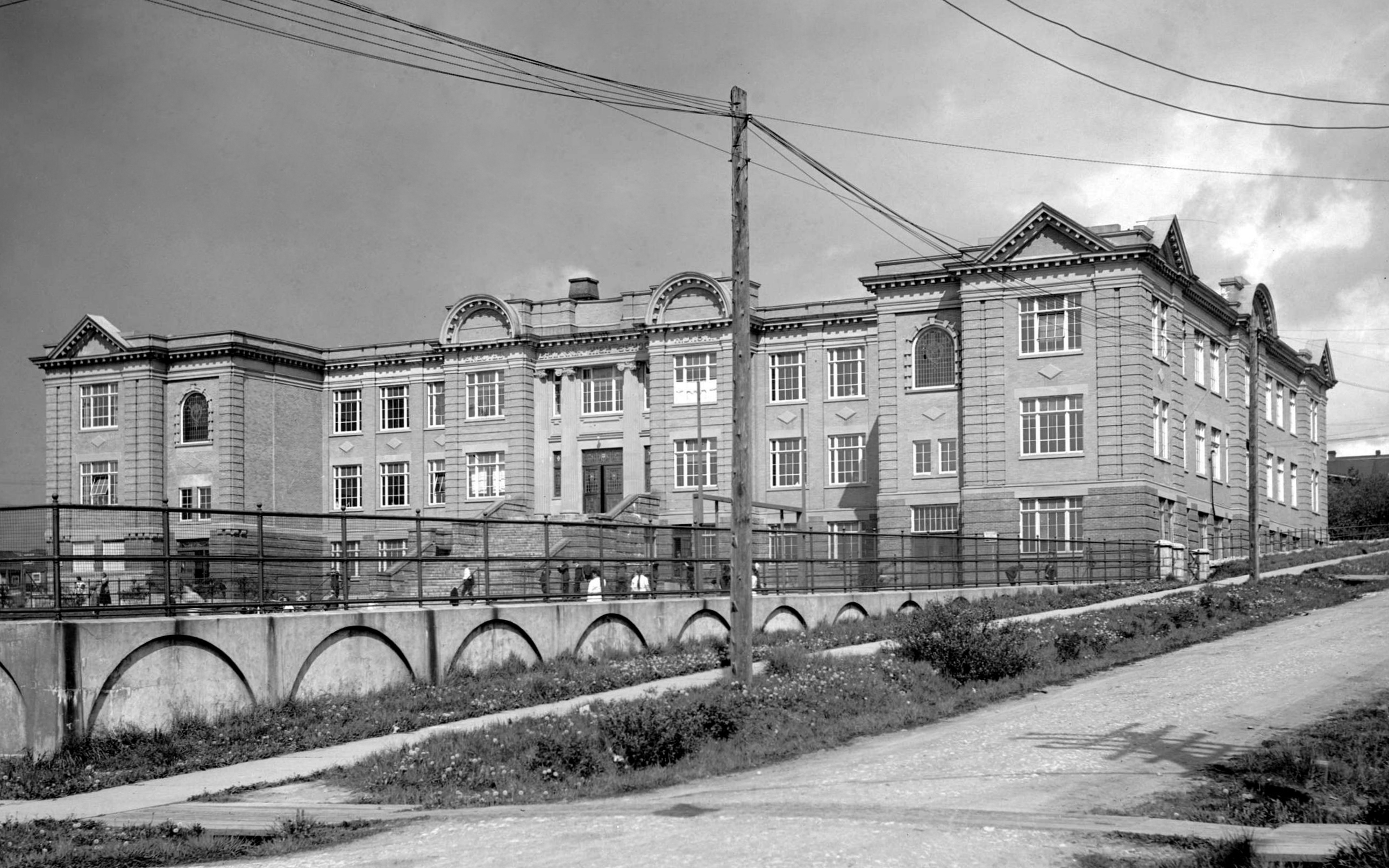
Britannia High School, looking towards the main entrance on the west side of the building.
6b) District of South Vancouver
ELEMENTARY SCHOOLS
General Brock Elementary School
1896 Carleton Hall (Sir Guy Carleton)
1900 General Brock
1902 Eburne Public School
1908 Collingwood Heights
1910 Tecumseh
6c) District of Point Grey
ELEMENTARY SCHOOLS:
1908 District Lot 472
1909 West Point Grey
6d) Hastings Township (amalgamated with the Vancouver School District in 1911)
ELEMENTARY SCHOOLS
1908 Hastings
1909 Lord Beaconsfield
6e) District Lot 301 (amalgamated with the Vancouver School District in 1911)
ELEMENTARY SCHOOLS
1893 District Lot 301
School Portrait
7. School Buildings: Design and Construction
Top: Lord Tennyson Public School; Bottom: Sir William Dawson Public School
Most school buildings were substantial in appearance as well as in size, reflecting the architectural styles of their day. In the first decade and a half of the twentieth century, most public buildings were designed in a classical vocabulary, based ultimately on architectural sources from Greece and Rome, as passed down by the Renaissance. So too were the schools. The archetypical school in both Vancouver and South Vancouver was symmetrically designed, its centrepiece adorned with classical columns and pilasters topped by a triangular pediment bearing an elaborate cornice.
Until 1909, the Board addressed school construction of a site-by-site basis, with individual architects for each project. As a result, the schools built during this period show considerable variety.
In addition to brick schools, a number of large wood structures were build during this period.
Typically, these early schools were built in eight-classroom units, with two floors, each with four floors. The basement contained play space divided into girls’ and boys’ rooms. Sometimes the attic housed an assembly hall. Until after 1900, no provision was made for specialized classrooms and administrative spaces were ‘found’ in hallways or classrooms. None of these early schools had a dedicated library. Most classrooms accommodated between 30 and 50 students.
Excerpts from Vancouver Schools: Establishing Their Heritage Value
8. District, School, and Classroom Organization
a) District
During the 1890s, Vancouver’s educational system developed all the characteristics typical of emerging bureaucratic urban school systems in North America at the time. These included:
- A hierarchy with a superintendent at the top and orders flowing from the top to the bottom of the organization…
- Clearly defined differences in roles of superintendents, principals, assistant principals, and teachers.
- Graded schools in which students progressively moved from one grade to another.
- A graded course of study for the entire school system, to ensure uniformity in teaching in all grades in the system.
- An emphasis on rational planning, order, regularity, and punctuality.
Excerpt from Vancouver Schools: Establishing Their Heritage Value
Note: The Vancouver School District’s first superintendent was W.P. Argue, former Deputy-Minister of Education for Manitoba. He was appointed in 1903.
b) School
The elementary school was divided into eight grades, defined by age. Each grade was assigned to separate classrooms.
Excerpt from Vancouver Schools: Establishing Their Heritage Value
c) Classroom Organization and Routines
Early classrooms were designed to facilitate teacher-centred instruction, with rows of desks, usually fixed in place, facing the front of the room. The class was taught as a group or, sometimes, broken down into smaller groups by ability. Large classes, with as many as 50 – 60 students, precluded individual instruction and made classroom discipline very important. Typically, primary classes were larger than senior classes. Women formed the bulk of the teacher workforce, with men teaching the smaller, senior classes and also supervising. Men were always paid more than women regardless of how much work they did.
At the commencement of school, a student monitor rang a hand bell calling everyone in. the student lined up – girls on one side and boys on the other – and marched into the school while another child hoisted the Union Jack.
The school day often began with the teacher inspecting each child for nits, clean hands and fingernails and possession of a handkerchief.
Former students remember single light bulbs hanging from the ceilings of large classrooms. Seating was arranged alphabetically in the first month but later students were placed according to how well they performed on the last test.
Teachers would often have students do exercises at the blackboard while the rest of the class worked at their desks or watched for mistakes.
Slower students often repeated grades. .. Many left school at an early age to work although some returned years later to complete their education.
Excerpts from Glancing Back
A standard classroom of the time (date and location unknown – possibly Vancouver High School)
9. The ‘typical’ Canadian Student
A number of the instructors are Old Country teachers, and they claim they cannot get as good results with Vancouver as with Old Country children. A comparison of the work would seem to justify this contention. The Canadian child is , on the whole, quicker to grasp a new idea, but he has a constitutional dislike for thoroughness. Despite the excellence of the school system, the pupils do not attain to the same degree of proficiency as children, even a couple of years younger, of the Old Land would under the very same teachers, because here the teacher is always up against the lack of home training, the absence of any feeling of the necessity of obedience, and the “I’ll do as I please” attitude on the part of the child. Thus, while unending care is being exercised in planning newer and better systems of education and money is being spent without stint, the children are not receiving the education they might, simply because of the failure of parents to do their part.
Excerpt from The Romance of Vancouver’s Schools
10. Course of Studies
a) Underlying Philosophy
According to Neil Sutherland, ‘from the 1880s to the 1920s, Canadians wrought enormous changes to curriculum and pedagogy which, taken together, were known as the ‘new education’…. Notable reforms that flowed from Dewey and others of similar mind included efforts to adopt pedagogical approaches less dependent purely on memorization and recitation …. and attempts to make school more practical, with the addition to the curriculum of manual training, domestic science, and other subjects. Concerns about physical health, especially in the context of urbanization, led to the development of physical education programs – which at first took on a military character – and to introduction of health services in schools… As part of this overall program of reform, training standards for teachers increased.
Excerpt from Vancouver Schools: Establishing Their Heritage Value
b) New Programs
Fairview Elementary School drill team (1901)
Recollections of Miss A. M. Ross:
Physical and military drill were introduced into the schools as early as 1898, and a special instructor, Sergeant-Major Bundy, a man with an excellent record for both military and naval service, appointed to take charge of this work. Drill was commenced in the primary grades, and carried on throughout the whole school course, and at the present time one of the most efficient bodies in the province is the troop of High School cadets.
With his barrel chest straining the brass buttons on his smartly-pressed uniform, his black moustache bristling, his military cap with a gleaming DCOR badge sitting squarely on his close-cropped head, his breeks and puttees immaculately rolled above his burnished boots… Sergeant major Bundy would stride into the school with gusto… Standing at rigid attention on Strathcona’s grounds, swagger stick tucked under his arm, the sergeant-major would line the children in parade ground fashion and… bellow orders in his best military manner: ‘left, right. Left, right. About turn. Keep in step! Stand at attention!’ ”.
…..
Recollections of Miss A.M. Ross:
Drawing was first into the schools in 1900, with a special instructor in charge…. Drawing is taught throughout the whole school course, beginning with the babies in the infant classes, and the numerous exhibits of work in the various schools testify to the excellence of the work being done.
The work in manual training has increased so that instead of the two centres originally opened (in 1900); there are now ten – eight in the public schools and two in the High Schools, with a staff of ten instructors. Manual training is taught to boys during the last three years of the public school course, and throughout the High School years. But though the number of centres has increased, the work has not broadened yet, only woodwork and joinery being taught.
Kerrisdale Elementary School: manual training centre.
General Brock Elementary School – manual training centre.
Recollection of Miss A.M. Ross:
Manual training is taught to boys during the last three years of the public school course and throughout the high school years. But though the number of centres has increased, the work has not been broadened yet, only woodwork and joinery being taught…….
Tennyson Elementary School – domestic science class.
Recollections of Miss A.M. Ross:
In the year 1905 domestic science, including sewing and cooking, was added to the regular school course for girls… Very excellent work is being done in both these branches. Very excellent work is being done in both these branches. Doubtless ere long the work of the housewife will be given the place and importance it deserves, and domestic labor be raised from being a menial task to being held in esteem as one of the most important branches of applied science.
A thoroughly competent supervisor in charge of the cooking kitchens… instructs her girls in the rudiments of bread-making, the proper methods of cooking meats and vegetables and the preparation of dainty and appetizing side dishes…
… she also gives them a thorough training in systematic methods, the work of her classes being performed with almost military precision, each dish in each girl’s cupboard being in its exact place, and even the knives, forks, and spoons being ranged like a row of little soldiers.
…..
Among the other improvements in the school curriculum in 1905 was the introduction of music throughout all the public school grades, which ever since has been under the supervision of a special instructor.
In 1909, the school board opened the first night school classes in B.C. with an astounding enrollment of 600 students. Only 200 people were expected to show up for English, estimating, home economics, navigation, sheet metal working and marine engineering. Course fees were set at $3.50.
Excerpts from The Romance of Vancouver’s Schools
11. Teacher Training
Normal School – Student Teachers Graduation Class portraits Photo Credits: City of Vancouver Archives
The rapid expansion in the number of school-age children in Vancouver during 1890 – 1910 created a huge demand for teachers. Many teachers, mostly young women, were recruited directly from high school, as early as the end of their Grade 11 year. Not surprisingly, their inexperience and lack of formal training often set them up for failure.
In 1891, Alex Robinson, then Principal of Central School, included the following statement in his report to the Superintendent of Education:
An earnest desire to promote the advancement of the pupils was noticeable in the work of all the teachers, and any cases of failure that may have occurred in the teaching of the particular branches are to be ascribed rather to inexperience than to a lack of enthusiasm. A Provincial Normal School is urgently required. As matters stand at present, to place over divisions containing 75 pupils and upwards, young teachers fresh from our High Schools, whose knowledge of method has been acquired by the reading of some text-book on the subject, is manifestly unfair both to the pupils and teachers themselves.
The term ‘Normal School’ that Robinson mentioned first come into use in the early 1800s in the United States in the early 1800s. It referred to schools where prospective teachers were trained in the standard practices, or ‘norms’ of teaching.
Ten years passed before Robinson’s recommendation came to fruition. In 1901, British Columbia’s first Normal School opened in the original Vancouver High School building. Successful applicants were given a four-month program. After one year, the School relocated to Lord Roberts School, and later, to the new Vancouver High School building, before occupying a purpose-built building at 11th and Cambie in 1909. There it remained until 1956, when responsibility for teacher training was moved to the University of British Columbia.Next door to Normal School was an elementary school called Model School, where student teachers could observe experienced teachers ‘modelling’ standard teaching techniques. This school closed in 1963.
Model School classroom
Link to photo gallery: Model School
12. Financing the School System
At first the Province paid the full bill for property acquisition and school construction. However it quickly retreated from this irksome financial responsibility. And so in 1888, the cities of Victoria, Vancouver, Nanaimo, and New Westminster became responsible for one third of their teachers’ salaries, and from 1891 they were required to pay, through property taxes, the full cost of providing school properties and buildings.
Excerpt from Vancouver Schools: Establishing Their Heritage Value
The Government grant on per capita began and for the first year (1892-93) amounted to $15,000… This year (1895) bode ill to the teachers, for through alleged “hard times”, we all got notice of “a cut” which, we were assured would be made up as times improved. The intentions were good, probably, but as far as the teachers were concerned, for many years the times did not get better, and so the old schedule was not restored. By this reduction, the City saved $7000 in a twelvemonth, though the Government grant was a thousand dollars more than the year previous.
Excerpt from A History of Vancouver’s Schools
(Note: the per capita grant was based on average attendance)
13. MILESTONES IN PUBLIC EDUCATION (excerpts from A Short History of BC Education, University of Victoria)
- 1896 In the interests of health and hygiene, Recess – a ten or fifteen minute break from lessons in the morning and afternoon – becomes mandatory in all public schools. Children were supposed to spend the time outdoors to permit the “atmospheric washing” [i.e. ventilation] of the classroom.
- 1905 The British Columbia School Trustees Association is instituted.
14. MILESTONES IN THE EARLY HISTORY OF THE VANCOUVER SCHOOL DISTRICT (excerpt from the 1978 Annual Report of the Vancouver School District):
- 1899 – First city superintendent of schools appointed
- 1899-1900 – “Physical culture and drill” added to the school curriculum
- 1900 – A special instructress in drawing began work in schools
- 1900-1901 – Manual training classes opened for elementary school pupils
- 1902 – A class in commercial subjects opened at King Edward High School
- 1903 – Attendance officer appointed
- 1904 – High school cadet corps organized; music supervisor added to staff
- 1905 – Home economics classes opened for elementary school students
- 1907 – The School District’s first medical officer appointed
- 1909 – Night school classes organized
- 1910 – First class for the education of “slow learners” opened
15. Excerpts from A Highlight History of British Columbia Schools by Shirley Cuthbertson (Royal BC Museum)
From 1901 to 1914, the number of high schools grew from 5 to 40, and the curriculum changed and developed from traditional classics and liberal arts to a more practical education. Commercial courses (besides book-keeping) were introduced in 1906 and Manual Training, started in 1901 (thanks to Sir William MacDonald, who funded facilities and equipment in Canadian schools), became an official high school course in 1908. Domestic Science was offered in Vancouver in 1909, and a full three year course in home economics started in 1917…
Technical courses grew out of “Manual Training”, were recognized as important to the public school system in 1914, and opened in King Edward High School (Vancouver) in 1919. Expansion of the program was helped by the federal Technical Education Act, which gave ten million dollars over ten years to assist the Province.

